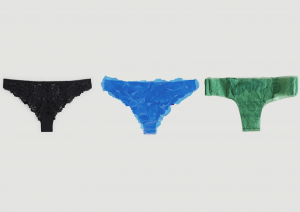
1- Documentation:
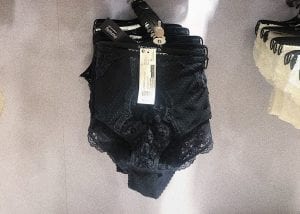
The chosen object: Lace Panties
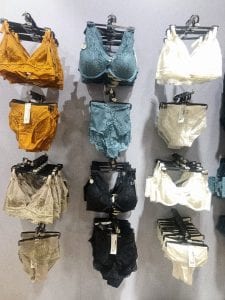
The section of the object: Woman Fashion section
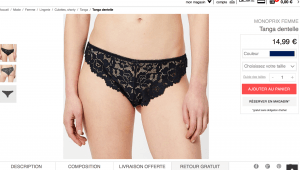
Researching about the object.
– Price: 14.99 euros
– Materials: 87% Polyamide 13% Elastane & the gousset : 100% Cotton
2- Sketches:

3- Transforming the object:

Chosen object: Lace Panties
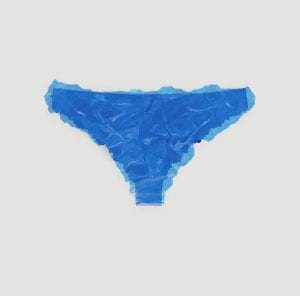
Redux: Plastic Panties (2D version, using photoshop)
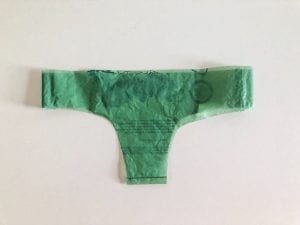
Tangible prototype (3D version of the plastic panties)
4- The reason behind the choice of the object and its transformation:
I chose to focus on this particular object because it strongly denounces feminine identity, which is one of my potential direction for this project.
I also wanted to focus on women’s underwear in order to understand the evolution of the lingerie industry and its social aspect.
I decided to change the material used in its fabrication in order to explore the different possibilities and then chose the alternative that would dramatically distort the value of the object, but also, its function.
My choice of alternating polyamide to plastic is also meant to denounce an environmental polluting issue which is the mass production in the fashion industry.
5- References and Research:
Thomas Teurlai , Foot locker
2015
Using his clay sculptures as part of a visual vocabulary, Teurlai presents an installation in which he shows his “different but identical” sculptures to denounce the contrast between the hand made and the machine made.
The reproduced object (sneakers) is still quite recognizable, but since the French artist decided to recreate it with clay it automatically loses its value, function and usage, and become more of a visual representation to convey a social or political message.
(Denouncing mass production)




Teurlai unearths the relationship between mechanical and industrial materials and experiences of the sublime.
6- Seminar D&A:
“Dress has an intimate relationship to the body. The materials we hang at the margins of our body — fabric, jewellery, paint or feathers — enjoy a close proximity to the flesh, outlining, emphasizing, obscuring or extending the body.”
From Corsets to Push-Up bras, lingerie has undergone many changes over time. For this project, I decided to focus on women’s underwear in order to understand the evolution of the lingerie industry and its social aspect.
The concept of lingerie is a visually appealing undergarment that was developed during the late nineteenth century. It freed women from the typical restrictive corsets. Corsets reached the height of their popularity during the Victorian era, only to be displaced in the 20th century by the mass production of a different kind of support garment.
It is especially during the First World War that women started creating a demand for more reasonable and comfortable alternatives. The U.S. War Department asked women to stop buying corsets, in order to use those materials for the war effort. Considering that situation, the lingerie industry began to use lighter fabrics. Few years later, brassières and underwire bras were introduced to the market and they quickly gained popularity. It is only after the 1960s that the female silhouette was liberated along with social mores. In the ’70s and ’80s, women typically bought two kinds of underwear: plain garments in department stores, and more expensive pieces for special occasions, like honeymoons. Lingerie had become a luxury, it wasn’t very accessible.
But things have changed a lot since. With the intervention of new technologies and new production techniques and facilities, the lingerie industry has become prone to mass production. Suddenly, lingerie became more affordable. Also, when big manufacturers and designers like Victoria’s Secret entered the market, it brought affordable lace thongs and padded satin bras to middle-class consumers, and made sexy lingerie more of an everyday thing. The term “luxury” started to lose its meaning in the lingerie world. Today, it is possible to buy lingerie from the supermarket and that is why we can find cheap lingerie.
When I first picked my object, I was very intrigued with the fabric composition, I was curious to know what’s behind that 14,99 euros panties. Then I found out that the lace panties was mainly composed of nylon, which is an unsustainable fabric. It simply presented the idea of mass production and it denounced the large impact it had on the lingerie industry.
I decided to change the material of that lace panties and replace it with plastic fabric simply because it would totally modify the value and the function of the object. The object wouldn’t bring the same comfort and modesty anymore. Women wouldn’t want to interact with it, nor to hang it at the margins of their bodies. It would totally lose its value and purpose.
I think that the transformation of my object isn’t just about distorting the value or exploring materials, it is referring to an environmental issue and it is meant to convey a strong opinion against mass production.
Bibliography:
- Entwistle J. (2002) The Dressed Body. In: Evans M., Lee E. (eds) Real Bodies. Palgrave, London
- Noel Duan. “A Brief History of Sexy Lingerie.” ELLE. October 11, 2017. Accessed February 22, 2019. https://www.elle.com/culture/g25697/history-of-sexy-lingerie/.
- Discovery News, Talal Al Khatib. “The Evolution of Lingerie Through the Ages.” Mashable. December 14, 2013. Accessed February 22, 2019. https://mashable.com/2013/12/13/lingerie/?europe=true#M2T5Sp2MdZqd.
- Quinne Myers. “What Does “Luxury Lingerie” Really Mean?” The Lingerie Addict – Expert Lingerie Advice, News, Trends & Reviews. June 01, 2015. Accessed February 22, 2019.https://www.thelingerieaddict.com/2015/05/what-does-luxury-lingerie-really-mean.html.
- Quinne Myers. “The Real Cost of Cheap Lingerie: Why Who Made Your Intimates Matters I The Lingerie Addict.” The Lingerie Addict – Expert Lingerie Advice, News, Trends & Reviews. May 22, 2015. Accessed February 22, 2019. https://www.thelingerieaddict.com/2014/06/human-aspect-lingerie-manufacturing.html.
- Finnigan, Kate. “Underwear Revolution: How Lingerie Grew up and Put Women’s Comfort First.” The Guardian. December 09, 2018. Accessed February 22, 2019.https://www.theguardian.com/fashion/2018/dec/09/underwear-revolution-how-lingerie-grew-up-and-put-womens-comfort-first.